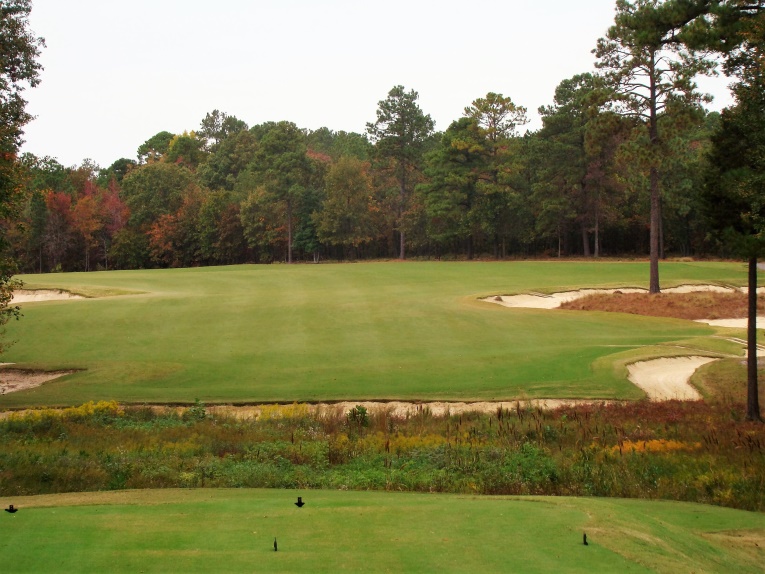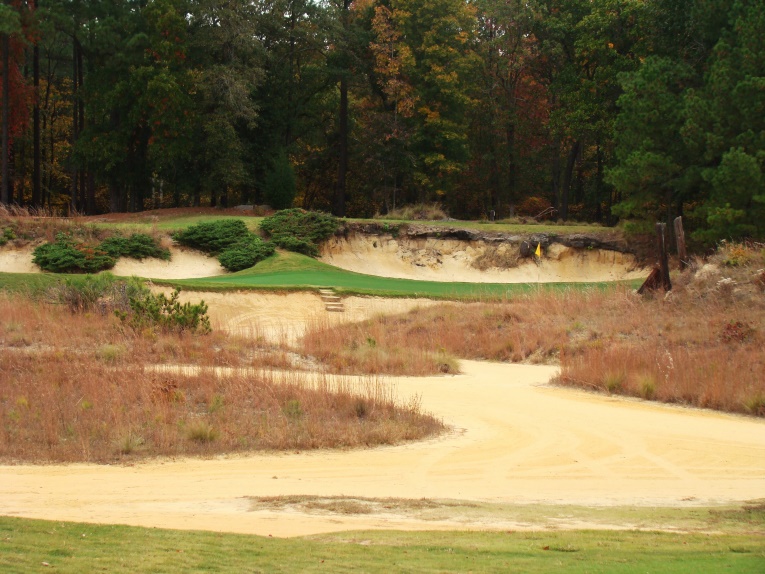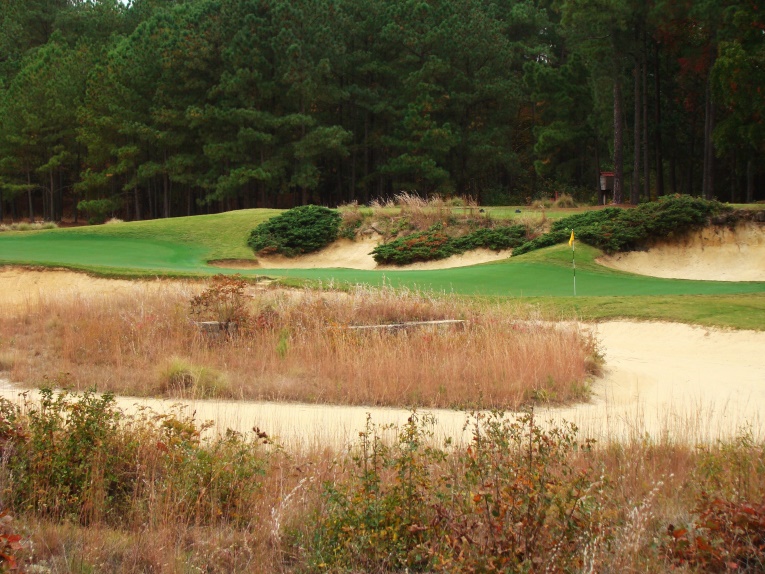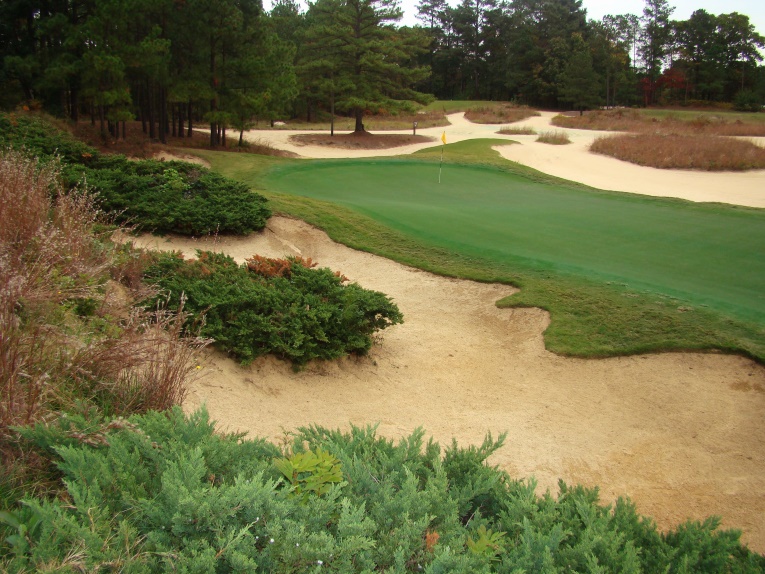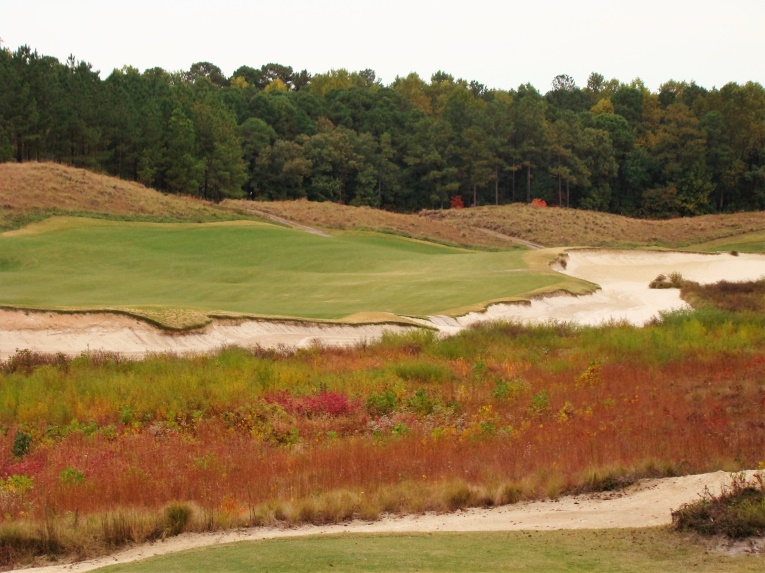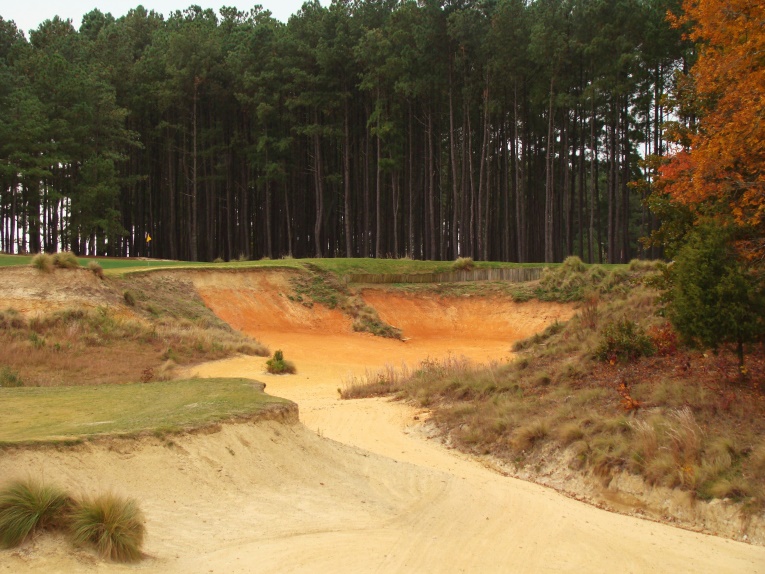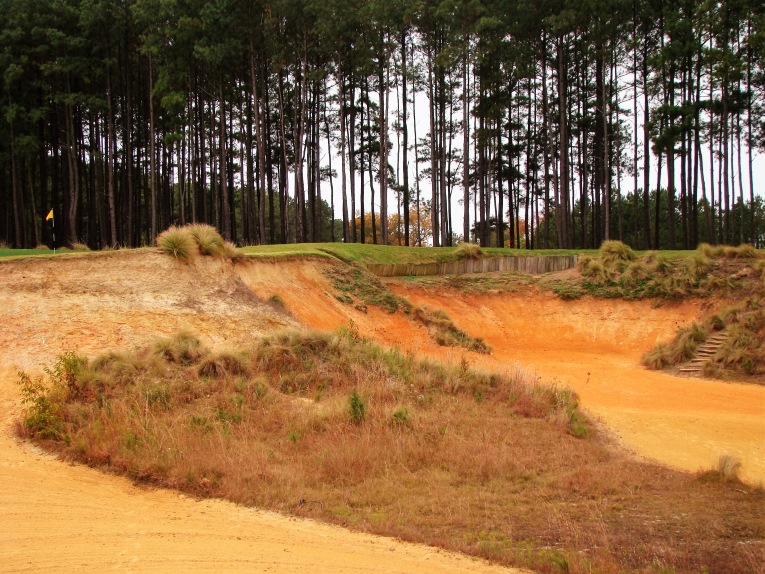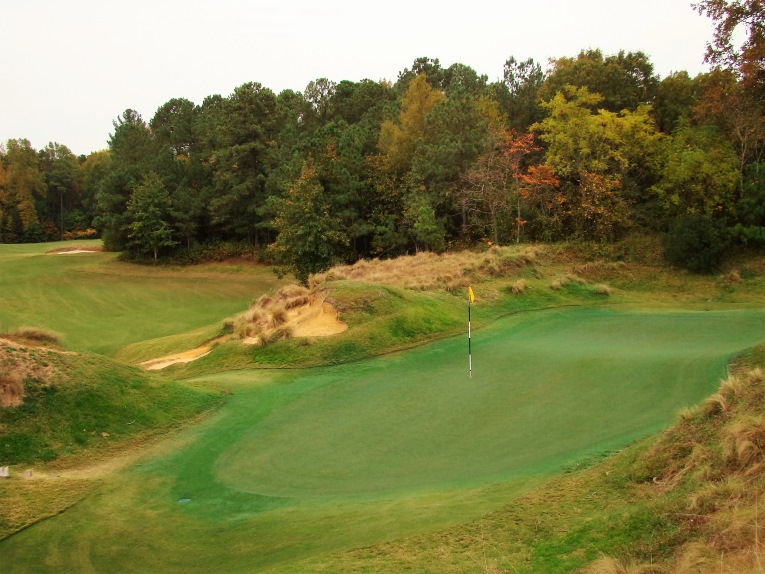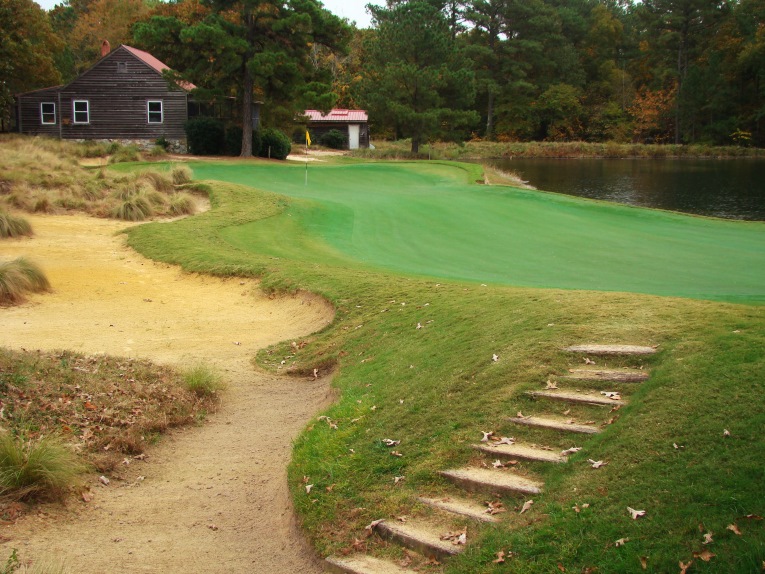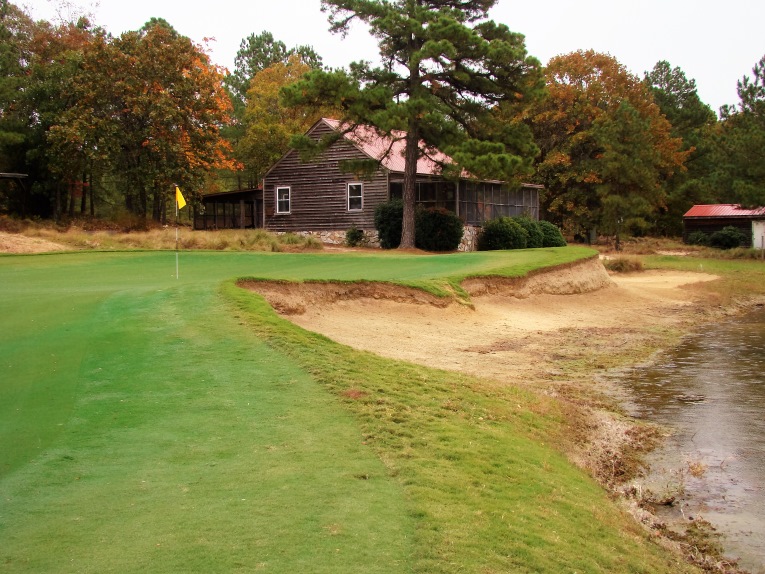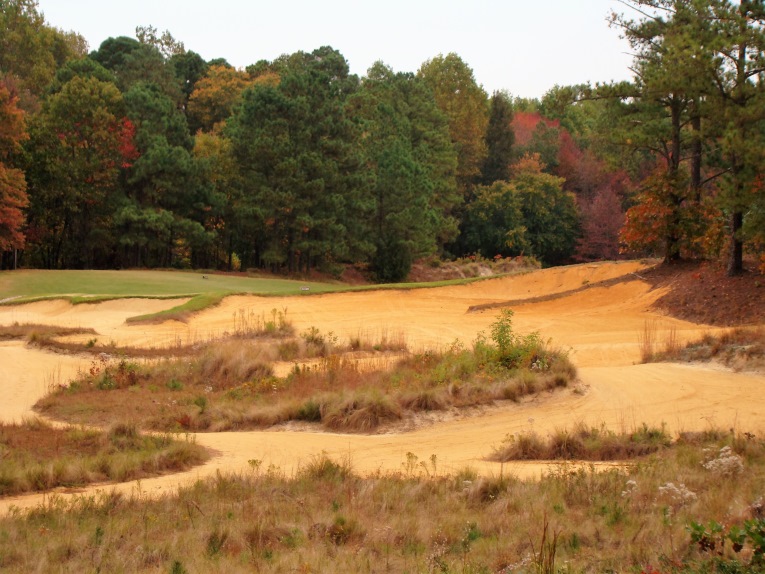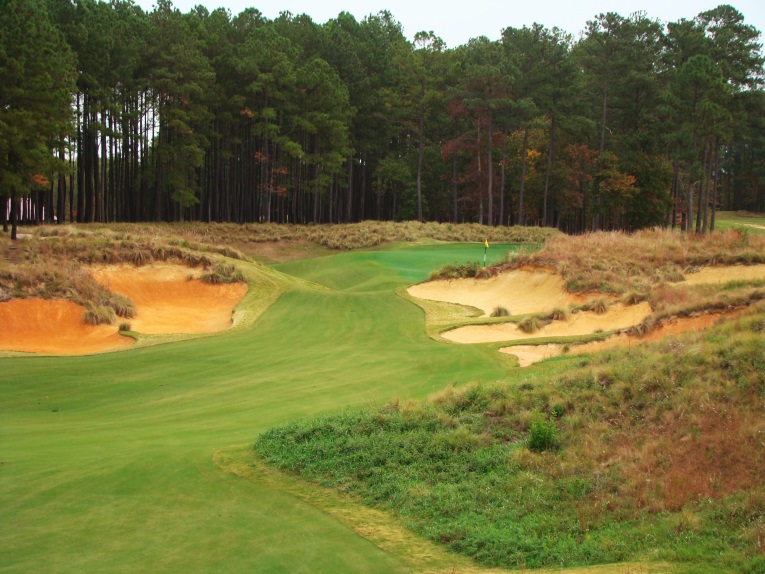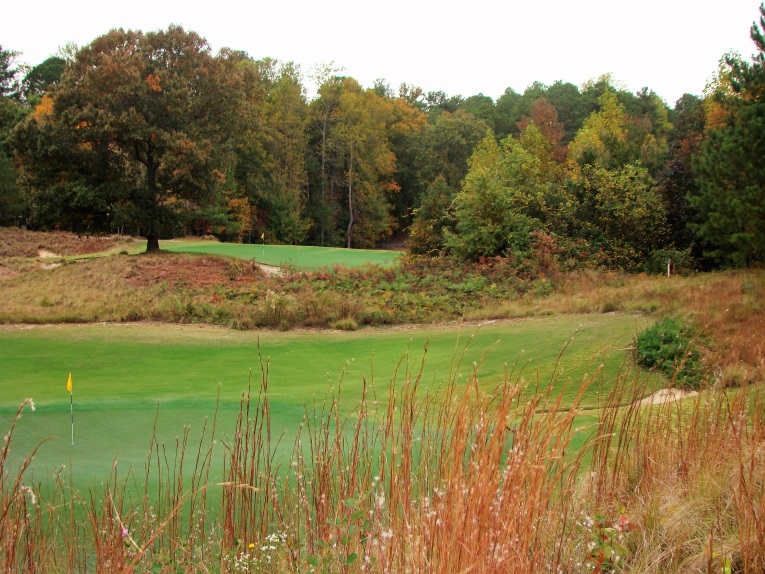Tobacco Road Golf Club
North Carolina, United States of America
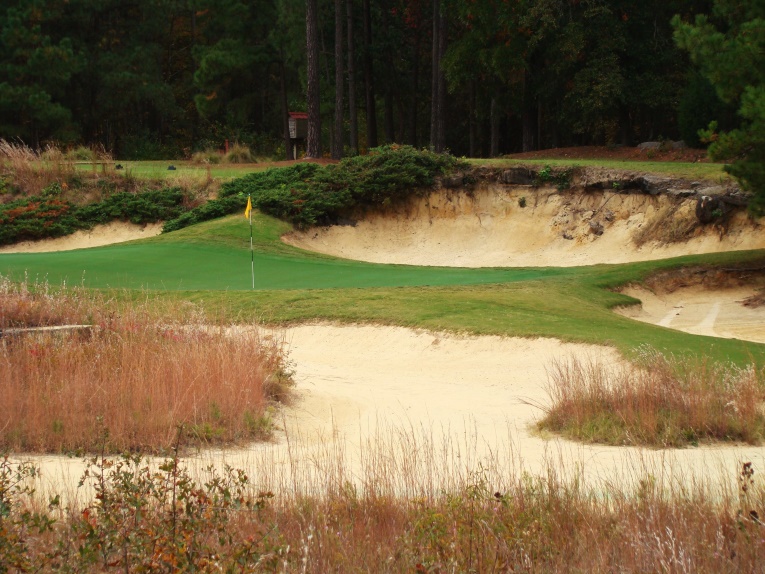
Mike Strantz was a unique artist, capable of producing handsome courses that are exciting to play. His talent shines through even on this rainy late October day.
How many architects produce fresh and original material?
Most modern designers fall into one of two categories: those that claim to follow in the footsteps of the ‘classic’ architects and those stamping out one similar course after another. It’s odd that the former group tends to be regarded as revolutionary, when, in fact, they are merely applying the time-tested concepts of others. They are unique only by comparison to the work done in the past fifty years.
Mike Strantz stood out as an architect capable of building something different and exciting – sometimes shockingly so. ‘I have never seen anything like this before’ is the standard cliché uttered after playing your first Strantz course. Heartbreakingly, Strantz passed away at the early age 50 in 2005, leaving behind nine original designs built between 1993 to 2003. Save for his first solo project at Caledonia Golf & Fish Club in 1993, his courses are tremendous in scale: fairways up to 80 yards wide, greens sometimes 60 yards deep or 60 yards wide, huge 25 foot deep bunkers and abrupt five-foot elevation changes on the putting surfaces. Along with Tom Doak, Coore & Crenshaw and a handful of other architects, he mercifully led a return toward wide playing corridors and a greater abundance of short grass. This small but influential group of architects re-introduced options and strategy into the game. Their work stands in stark contrast to the unimaginative ‘championship’ courses dully bunkered left and right.
Strantz wrote in his June 2000 Feature Interview,
WIDTH IS KEY! When you start reducing width (and I mean air space as well as fairway width) you begin to reduce the number of options for players of various skill levels, thereby reducing the total number of players who can successfully navigate their way around the course. I guess that’s fine if we only want scratch to 10 handicaps playing golf. The comment about wide fairways presenting no challenge to the good player is pretty weak, at least on our courses. Go check out any of our fairways and it becomes apparent that you must be in certain spots to gain an advantage on the next shot or approach to the green.
We realize now, some 20+ years into this movement, too much width can be excessive but at Tobacco Road, Strantz struck the perfect chord where the fairways and greens complement one another. Examine the dramatic two shot seventh and its severe green, bunkered front and back with a significantly lower front-left section and a flat but shallow back-right portion. Some golfers bark that back-right hole locations are almost impossible as there is too little room to stop a ball on the plateau. That is true – if you approach the hole from the right but that fairway is 70 yards wide so the player has plenty of room to drive down the left to better open up such back-right hole locations.

The angle into a top tier hole location at the seventh is much more user-friendly from forty yards left of where this photograph was taken.
How fortunate the golf world is that Strantz built Tobacco Road and lent a breath of fresh air to central North Carolina. Famously a devoted family man, he was loath to travel outside of his home state of South Carolina and if Tobacco Road developers Mark Stewart and A.K. Woodell hadn’t mentioned that they had an abandoned quarry, Strantz might never have explored the opportunity! Listen to Stewart’s account of events in 1995:
‘My partner and I wanted to build a ‘golf only’ facility. Our mantra was ‘No Swimming. No Tennis. No Out Of Bounds. Just Golf.’ We owned most of today’s site on Rocky Fork Church Road yet we were quite neutral about it. Although the mining spoils and contours seemed to have a lot of potential, we wanted to build the best course possible, even if that was somewhere else. We were performing due diligence on various architects when someone mentioned ‘the guy who did Caledonia.’ After a week of trying, we finally reached Mike at the Caledonia maintenance building, where he had started to build True Blue. Initially, he wasn’t interested because he wanted to work within an hour of his home in Mount Pleasant. At the end of the call, we threw out that we had an abandoned sand pit as one of several potential sites and said, ‘If you change your mind, please let us know.’ The very next day he called back and said ‘I’ll be there Friday.’
Though Strantz had a flair for the dramatic, his designs are natural extensions of the native terrain. At this abandoned quarry and its mix of clay and sandy loam, he found a myriad of appealing attributes including sandy pits, gnarly vegetation, wetlands, and significant land movement. Stewart continues:
We didn’t know who Mike was or what to expect. When he got out of his truck, he was bigger than life: 6’4″ with long locks like Sampson but quiet and humble. We wandered over the site of Holes 13 – 18 and then spent time where Holes 5 and 6 were eventually built. He seemed convinced that he could do something special here. After we chose Mike, the bank required us to perform a feasibility study, which concluded that we were in no man’s land, too far from Pinehurst and/or Raleigh to be successful. We had our eye on other properties north and south of today’s site but thankfully, Mike stepped in and said ‘Trust me, boys, this is the site you want.’ Between Mike’s confidence and a boatload of collateral, we got the bank to go along and here we are.
His routing skates around the irregular shaped, 230 acre property, which includes 30 acres of jurisdictional wetlands that he worked around. Where Strantz moved a lot of dirt, he did so purposefully. For instance, the two big mounds off the first tee enabled the placement of the ninth green, first fairway and tenth fairway in a relatively compact area. Yet, the feeling on first tee is one of spaciousness. In the middle of back nine he built up a hill to wall the property off from a commercial enterprise next door. His magic barricades the outside world to create an oasis of pure golf.
Some critics who sniff at such earthmoving and can only treat minimalism seriously completely miss the point. Innovation and variety within architecture are crucial for the overall development of the profession and the game. More importantly and unlike the typical fare produced by some big design firms, Strantz courses make you think on many different levels. Some golfers embrace this psychological spelunking while others become rattled and lose their composure. What’s quite special is that all golfers react powerfully to Tobacco Road, a few with disdain but for many it engenders one of the most loyal fan bases in golf, something very much appreciated by the owners.
Additionally, the owners delight in how Strantz built a maintenance-friendly course. Wide fairways typically indicate a large budget. Not here, where the maintained surface is less than one third of the course property, thanks to the liberal use of sandy waste areas. There is little rough – you are on a prepared surface or you’re in the scruffy stuff. Since opening for play in 1998, there has not been a design change of substance. The most expensive undertaking since the course opened was an upgrade to the latest Bermuda strain in the summer of 2014.

The average golfer should hit plenty of fairways and greens at Tobacco Road but reaching a green like the fifteenth is just the beginning – the golfer needs to find the right section in order to score.
Doc Lachicotte, one of the developers of Caledonia/True Blue, rode up with Strantz for the initial visit. As they stood around the bulkhead of what became the sixth hole, Lachicotte suggested to the owners that ‘If you do this, build a “1” or a “10”. Don’t build a 4/5/6.’ Let’s see what happened.
Holes to Note
First hole, 560 yards; There are nearly 1,000 golf holes in neighboring Moore County. Many of them are bland to the point that they are forgotten during the round itself. In stark contrast there’s this opener, which is loved by some and loathed by many. Without question, it tells the golfer he is about to experience something different. Much is made about the tee shot played through what is perceived to be a “V” created by two large hills that Strantz built. It might be the single most polarizing opening tee shot in golf. Get away a good one and the sight of the ball bounding along the fairway on the far side is immensely satisfying. Get caught up on either hillside and the cursing begins! Chris Brown, Director of Golf, thinks the hole sums up much of the design: ‘You have immediate visual intimidation but the hole never plays quite as hard as it appears at first glance. The right hill is actually closer to the tee and to carry it is no where near as long as carrying the left. Therefore, the average golfer who fades it is pleasantly surprised how often his ball makes it into the fairway on the far side. Meanwhile, the strong golfer needs to carry the left hill in order to 1) gain an extra 15-20 yards of roll courtesy of how Strantz contoured that section of the fairway and 2) enjoy the most advantageous angle into the green, which is open front left. To me, the hole is full of strategy for the strong and not so strong golfer. It is not always obvious to the first timer what to do but I think that adds to the course’s appeal.’ The author concurs, though he admires the hole more for the final 250 yards than the first 250 yards. In fact, he considers the green – canted hard from front left to back right and placed behind a mound – to be one of the best, most underrated ones on the course. The tee shots garners the attention/controversy and by so doing, inadvertently overshadows the terrific green complex.
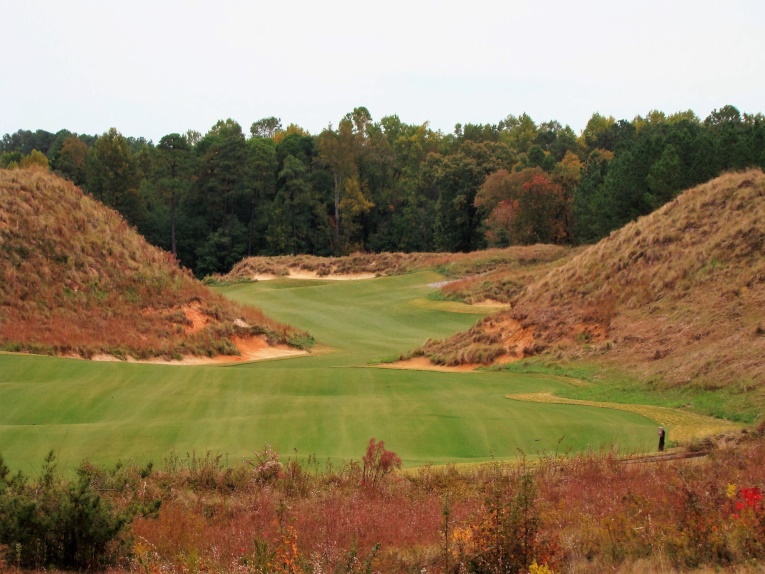
Game on! The two hills are actually staggered with the right hill a good 20 yards closer to the tee than the left one.
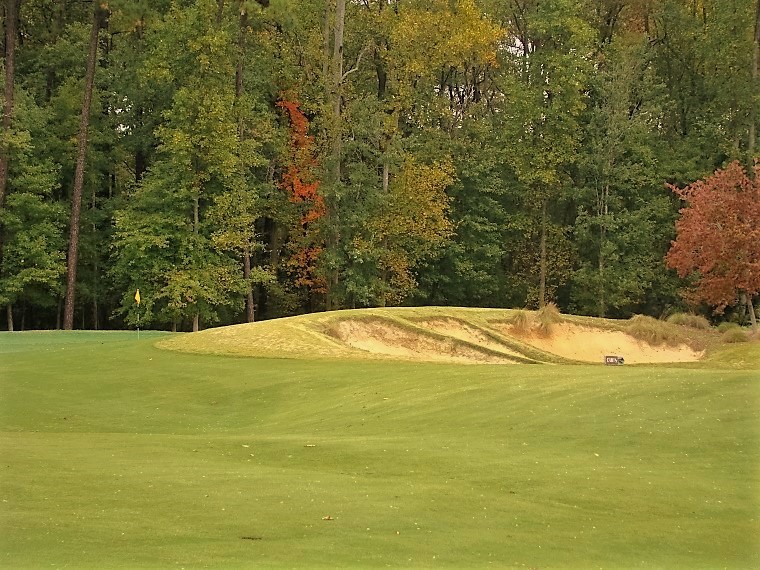
If the golfer can clear a second set of hillocks 100 yards from the green, he is left with this pitch to a green that slopes away back right. Give Strantz credit for the hillock in front and the three deep pits dug into it.
Second hole, 390 yards; Ignoring the par 3s, the golfer is likely to see the flag from the tee only thrice, at the fifth, seventh and ninth. The flag is otherwise blind for a variety of reasons, including doglegs (e.g. 2, 4, 10, 11, 12 , 13, 16, 18), mounds (e.g. 1, 2, 15), elevation change or all three contrivances as seen here at the second. Indeed, there is nothing that approximates a flat hole at Tobacco Road.

As seen from high right, the long scar bunker that extends from the middle of the green is one of the smallest and meanest hazards on the course, full of awkward lies and stances.
Fourth hole, 535 yards; An exemplary risk/reward hole of the sort that should exist in droves in the sandy environs of Pinehurst/Southern Pines – but doesn’t. Its length is misleading because the hole bends sharply left around a sandy area; the effective distance is reduced to some 470 yards for those who hug the left side. Reaching the green requires a heroic shot over 180 yards of sand and scrub to a slightly sunken green where the option exists to bounce the ball home off a front-right slope. The hole is enjoyable for the high handicapper too as the voluminous fairway allows him to circumnavigate the trouble, although the farther right he plays his second (away from the sand), the more difficult his third. This ‘button hook’ hole was a favorite of Strantz’s for good reason and is featured at True Blue, Royal New Kent, and Tot Hill Farm.
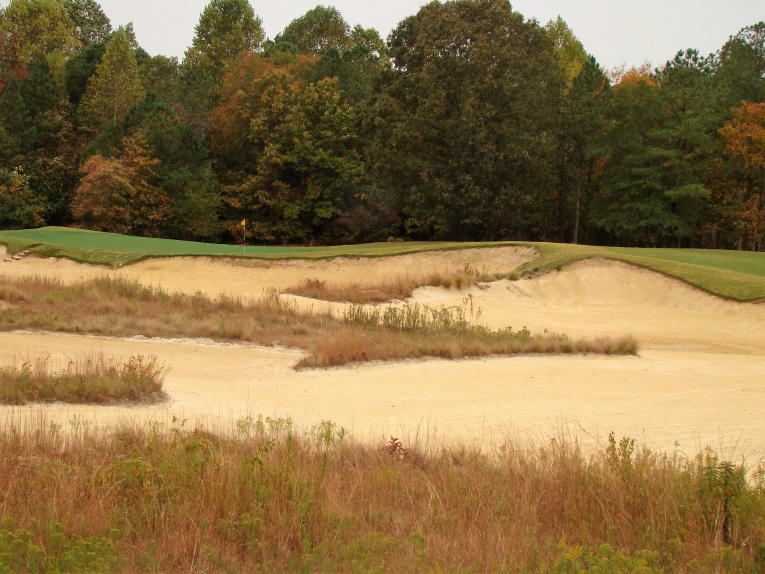
… the opportunity to have a crack at the green in two. The rest of us take the longer route to the right around the trouble.
Fifth hole, 335 yards; Somewhat reminiscent of the fifteenth at Tom Fazio’s stylish World Woods (Pine Barrens), where Strantz worked, a large sandy hazard extends along the direct line from tee to green. Despite playing uphill, plenty of golfers take the bait and have a slash at driving the green. Should one come up short, the recovery is either a brutal 60 yard explosion shot or a ticklish thirty yard chip from tight grass to an elevated green with a pronounced false front. For those who play prudently away from the green and into the right fairway, the resultant pitch is still no bargain to a shallow, crowned plateau target that sheds balls. While the good player might hope for a birdie on a hole of this length, ‘wishing’ and ‘achieving’ are two different things.
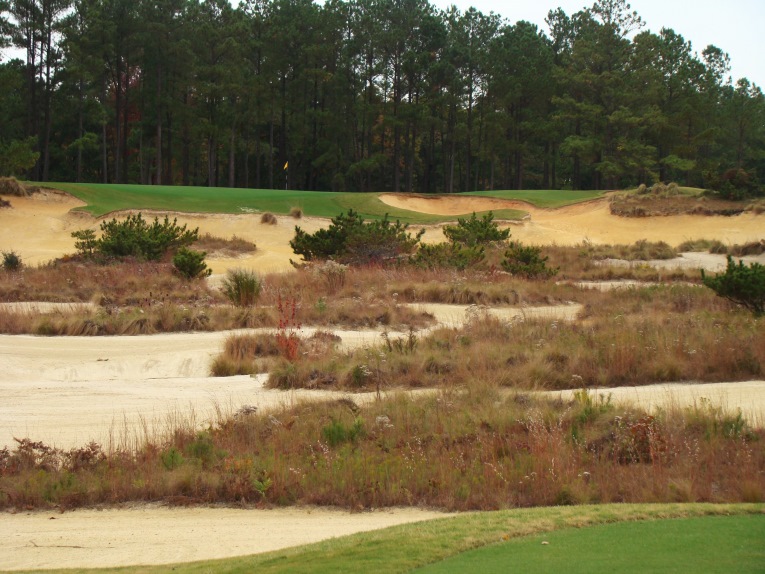
The direct line to the green is a carry of 230 yards to clear the sand and 260 yards to reach the putting surface.
Sixth hole, 150 yards; This hole is situated in the northern finger of the club’s property and as such, there is out of bounds on three sides. So what did Strantz do? He built a hole with five different tee areas across a 70 yard wide expanse and coupled them to a very wide green. From the far left set of tees the green is 23 yards deep and 48 yards wide, a shallow target for a 7-iron across a sea of sandy scrub. From the far right, almost at a right angle to the first, the green becomes 48 yards deep and 23 yards wide. For the latter set-up the hole is usually positioned on the front of the green, leaving the player a shot of some 120 yards resulting in a look suspiciously like the 13th at Merion. It plays well both ways and on consecutive days with the tee-markers in different locations one will scarcely recognize the hole. Conventional? No. Does it work? Absolutely.
Eighth hole, 180 yards; Strantz worked for Tom Fazio at some of his very best designs including Wade Hampton and the Pine Barren Course at World Woods. He learned much during that association including how to create holes with ready, visual appeal. Yet, Strantz was his own man and some of his most unique ideas are manifested by the startling greens he built. Just take a look at the eighth below; see how the green rises from the low front to a level greater than the flagstick?! First and foremost, Strantz loved links golf and believed that how the ball interacts with the ground is at the heart of golf. Strantz, keen to replicate such, was limited by the Southeast’s weather and grasses. Eventually he discovered and determined that building greens like this where balls travel unusual distances along the ground would thrill golfers.
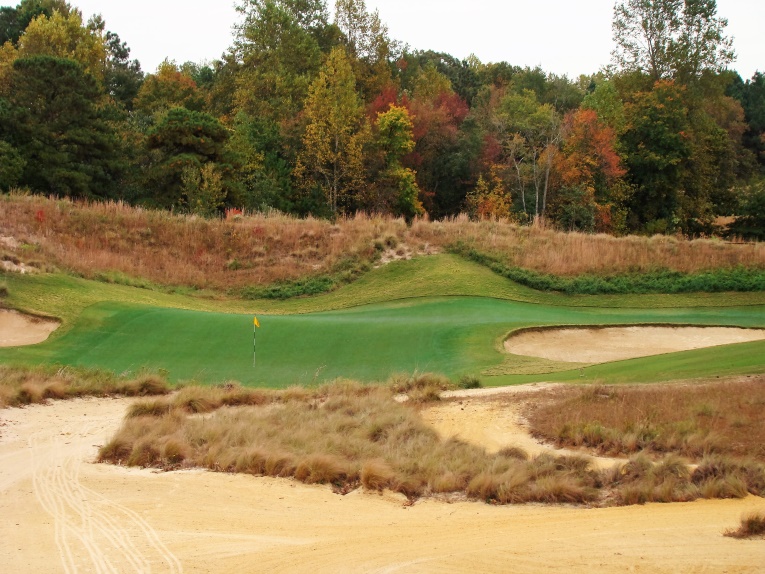
This is a hole-in-one location, lots of tee balls land past the hole, take the bank, and then slowly retreat to the hole. Back right hole locations require an entirely different type shot.
Tenth hole, 440 yards; The boldest design risks that Strantz took at Tobacco Road – like the hills at the first, the bath tub green at the thirteenth, the blind tee ball on sixteen – dominate post-round conversations to the exclusion of some highly appealing, albeit conventional features. For instance, the graceful sweep of the tenth fairway and the green itself took real talent. Same with the aforementioned fallaway green at the first, the false front on the fifth green and the saddleback twelfth green with its front to back pitch. Such classic features tend to be overshadowed by the more audacious aspects of the design.
Eleventh hole, 540 yards; This gambling three shotter that swings right is somewhat a mirror-image to the fourth but more daunting as it bends around a 25 foot deep (!) sand pit. Unlike water at the famous thirteenth at The Dunes in Myrtle Beach, a sand pit offers a chance of recovery and becomes more flirtatious. Thus, the better player can give the green a go in two but still salvage par if he comes up short in the pit. Meanwhile, the hole is thrilling for the weaker players who can successfully bumble along the fairway that wraps around the fearsome hazard. No golfer likes to be pandered to and this hole shows how Strantz allows all golfers a genuine sense of accomplishment by avoiding an intimidating hazard.
Thirteenth hole, 575 yards; Critics of Tobacco Road sniff at the number of long, shallow greens and/or the number of blind shots. The thirteenth has both and joins the first and sixteenth among the most polarizing holes. Yet, the hillock that obscures 80% of the green and the sunken bath tub in which Strantz built the narrow green were always there! Minimalists should rave about this green placed in a natural dell. It is celebrated at Lahinch – and part of Irish lore. Tobacco Road has been open for nearly twenty years and the owners have witnessed a gradual warming to this hole by Americans.
Fourteenth hole, 180 yards; The fourteenth confirms Strantz an artist who appreciates strategic play. The narrow, angled green pinched in its middle, the bunkers flowing into the water, the lake and the shack behind the green all conspire to create a postcard-perfect composition. However, the left to right slope of the green (toward the lake) makes the hole so darned difficult that anything played away from the lake to the left leaves an almost impossible up-and- down. This exacting hole requires the surest iron shot of the day.
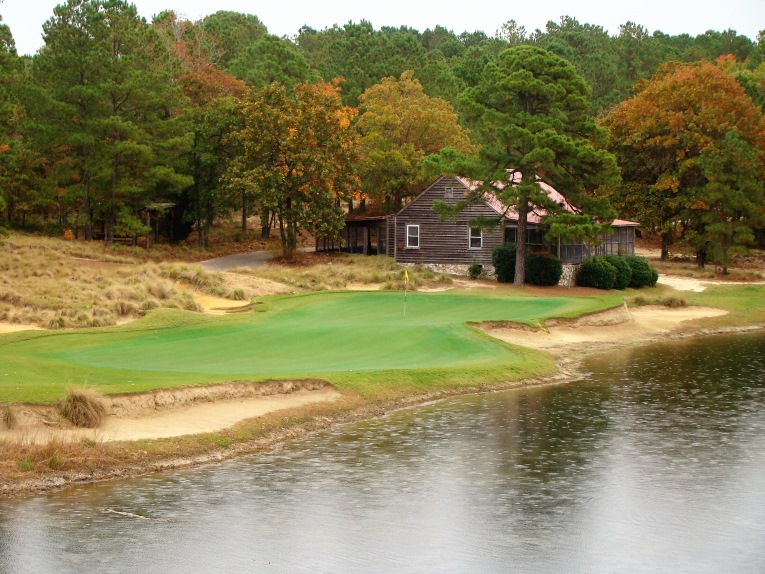
Even with rain coming down, the beauty – and challenge – of the downhill one shot fourteenth is evident.
Fifteenth hole, 365 yards; It’s very revealing that owner Mark Stewart oscillates between this and the ninth for his favorite hole. Because both require an abundance of local knowledge to reveal their charms and strategy, many first time visitors place either or both toward the bottom.
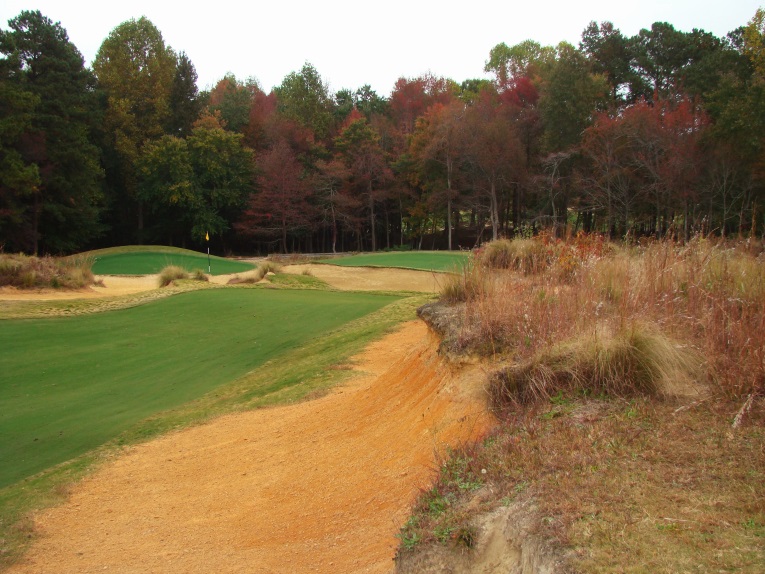
This 70 yard long mound, left behind from the mining days, runs perpendicular from the right edge of the green toward the golfer.
Sixteenth hole, 325 yards; Give Strantz credit: Tobacco Road stirs emotion. A few golfers throw their hands up, never to return but Adam Lawrence’s wonderful European magazine Golf Course Architecture asked a host of golf course architects to select their favorite designs and Tobacco Road made that world top 100 list. Much more puzzling, Tobacco Road was ranked 10th on the Golf Digest list of the country’s toughest courses in 2007 (67th in 2011). Say what??!! We are talking about a 6,500 yard course that plays to wide fairways and where water is in play at one hole. Half par holes to the low side abound, including the first, fourth, fifth, eleventh, thirteenth, seventeenth and here at the drivable sixteenth. Half par holes to the hard side are only the ninth and eighteenth. So, to the author, the course clearly provides scoring opportunities and is geared toward fun. Having said that, you stand on this tee, clueless where to go – and agree with Golf Digest! As the shortest two shotter on the course this hole is – and should be – well defended. The tee ball calls for a blow with a three wood over a mound covered in thick grass to the unseen fairway.

As seen from behind, the two tiered green requires a deft approach shot. Many sad three putt bogeys have resulted from shots that spin back to the lower tier when, alas, the hole is not there. Exacting golf is crammed into this little brute, which is especially appropriate given that it falls late in the round.
Seventeenth hole, 140 yards; The author remains unsure about this hole but every time he plays it, someone in the group does something spectacular. At first glance, another sixty yard wide, shallow green seems a bit of deja-vu. Yet the back-to-front bowled green produces a lot of slow motion balls rolling across the putting surface. Sometimes it’s rolling toward the hole but often it’s meandering farther away. An elevated tee gives the golfer a very clear report as to the direction and merit of his shot.
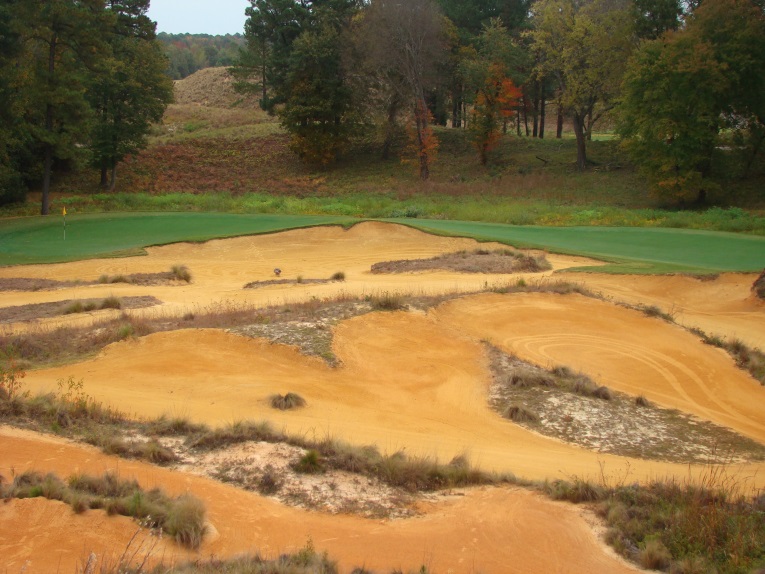
The seventeenth green is nearly as wide as half the length of the hole! Highly irregular to be sure but it does utilize the space nicely.

As Strantz explained to the owners, a hole should be like a piece of carved wood and appear attractive from all angles. As seen from behind the green, Strantz delivered.
Eighteenth hole, 430 yards; After a series of relatively short (though hardly easy) holes, the tee at the Home hole immediately brings to mind the bruising finisher at Merion, where a lengthy carry is needed to reach the fairway on the other side of a quarry. The approach is nearly as intimidating, played through a cut in the hillside, where deep bunkers 30 yards short of the green hide the real trouble: sharp eight-foot drop-offs into closely-mown areas on each side of the raised green. With onlookers on the clubhouse porch nearby, the ticklish chip becomes harder.
In his all too short career, Strantz gained a reputation for melding a host of appealing, conventional shots with unconventional dramatics. Mike Strantz’s fifth course combines appealing aspects of his earlier works: the scale and drama of Royal New Kent and the cunning and charm of Caledonia. To the author, he got the best mix at Tobacco Road. The watery finish at Royal New Kent seems like drama created for drama’s sake at the expense of good golf. There are no such out-of-character missteps here where the best qualities of the abandoned sand quarry remain front and center throughout the round. Tobacco Road is not about length; everything is within reach. Rather, it is about fun and keeping your wits about you as you play past intimidating hazards in an environment undiluted by housing. This is a highly original course created with less than half the budget of name architects and their ten million dollar projects. Tobacco Road is pure golf that open-minded golfers find irresistible.
Let the concluding words be Strantz’s as he wrote of Pete Dye in his June, 2000 Feature Interview:
Pete took what was becoming a trend toward cookie cutter sameness in ‘modern’ golf course architecture and turned it on its ear by pushing it to the very edge. To me, when Pete separated himself from the pack in the 70’s, it was like a breath of fresh air. He forced people to start looking at golf course design with a whole new perspective. He believed in what he was doing and persevered despite a firestorm of criticism and controversy. His work was so bold and so different, that I think people failed to grasp the basic fundamentals of design philosophy it contained. I think that Pete is probably the best in the business at setting up the angles and diagonals of play. Go play any of his courses and you’ll see what I mean when you look at them in that context.
We know who else that describes.
The End



